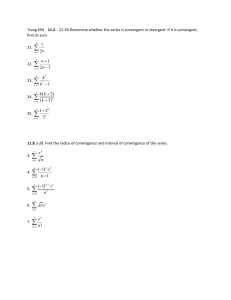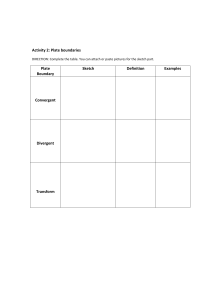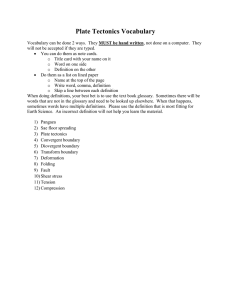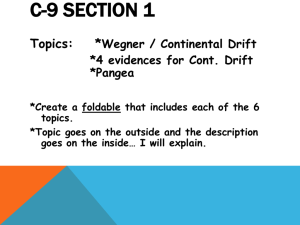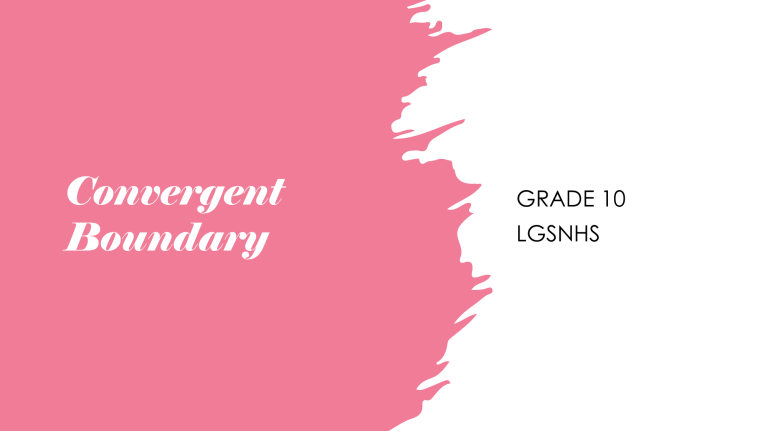
Convergent Boundary GRADE 10 LGSNHS Objectives • Identify the three types of convergent boundary. • Compare and contrast the three types of convergent boundary. • Suggest ways on how to contribute to government efforts in reducing damage due to earthquakes, tsunamis, and volcanic eruptions. Presentation Title In the following figures which image of arrows illustrated convergent boundary? A. B. C. 3 What is convergent boundary? 4 What are the three types of convergent boundary? Oceanic – Continental Convergence Oceanic – Oceanic Convergence Continental – Continental Convergence 5 What geologic activities are formed in each type of convergent boundary? Oceanic – Continental Convergence Oceanic – Oceanic Convergence Continental – Continental Convergence • Trench • Trench • Earthquake • Earthquake • Earthquake • Volcanic Arc • Volcanic Island Arc • Mountain Ranges 6 Earthquake is the common geologic activity of the types of convergent boundary we experience here in Davao City. What do you do during an earthquake? 7 Based on the map answer the following questions: 1. Plate Y is an oceanic plate. When it converges with the continental Plate X, what will happen? 2. Between Plates Y and X, which one will undergo subduction? 9/3/20XX Presentation Title 8 Identify and encircle the convergent boundary. Write the plate boundary on the space provided. 9 Answer the following questions based on the image provided. 1) What type of convergent-boundary is the image provided? 2) Identify the numbered parts of the image. 3) What numbers indicate the layers of the earth? How about the geologic features formed in this type of convergence? 4) Explain what happens in this type of convergence. 5) What is the difference between this type of convergent boundary from the other types? 10 Answer the following questions based on the image provided. 1) What type of convergent-boundary is the image provided? 2) Identify the numbered parts of the image. 3) What numbers indicate the layers of the earth? How about the geologic features formed in this type of convergence? 4) Explain what happens in this type of convergence. 5) What is the difference between this type of convergent boundary from the other types? 11 Answer the following questions based on the image provided. 1) What type of convergent boundary is the image provided? 2) Identify the numbered parts of the image. 3) What numbers indicate the layers of the earth? How about the geologic features formed in this type of convergence? 4) Explain what happens in this type of convergence. 5) What is the difference between this type of convergent boundary from the other types? 12 Fill each blank with the correct word found in the parenthesis. • As continental plate converges with an oceanic plate, the (1) __________ (continental, oceanic) plate dives under the (2) ___________ (continental, oceanic) plate. The process of diving towards the mantle is called (3) _________ (subduction, floatation). When two oceanic plates converge, the denser plate subducts. Once its leading edge reaches the mantle, it melts into a (4) __________ (magma, crust), builds up a pressure that makes it push the ground above it, forming a (5) __________ (volcanic island, mountain). The convergence between two continental plates results to a landform called (6) ___________ (volcanic arc, mountain ranges). Since both plates have the same densities, no plate subducts under the other. There is no (7) ___________ (volcano, mountain) formation. However, since the ground moves, a phenomenon called (8) ____________ (earthquake, storm) may be felt in nearby places. 13 Complete the convergent boundary table. Type of Convergent Boundary OceanicConvergent Boundary Movement (Draw using arrows) Geologic Activities Earthquake Trench Crust Involved Oceanic & Oceanic Crust Example or locations with convergent boundaries 14 Thank you! Grade 10 Bonifacio
